Investigating, Evaluating, and Remediating Moisture and Mold
Problems

|
Moldy Areas
Encountered During an Investigation |
|
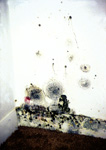 |
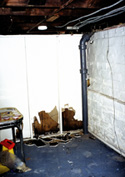 |
[Click on image
for larger picture]
Photo 3A: Mold growing in closet as a result of
condensation from room air |
[Click on image
for larger picture]
Photo 3B: Front side of wall-board looks fine, but the back
side is covered with mold |
Mold Remediation - Key
Steps
[select the
JPG
version (48KB file) or the
PDF
version (168 KB adobe acrobat file) of the Key Steps Flowchart]
- Consult health professional as appropriate throughout process
- Select remediation manager
- Assess size of mold problem and note type of mold-damaged
materials
- Communicate with building occupants throughout process as
appropriate to situation
- Identify source or cause of water or moisture problem
- Plan remediation, adapt guidelines to fit situation, see
Table 1
& Table 2
- Select personal protective equipment (PPE)
- Select containment equipment
- Select remediation personnel or team
- Choose between outside expertise or in-house expertise
- Remediate
- Fix water or moisture problem
- Clean and dry moldy materials See
Table 2
- Discard moldy items that can't be cleaned
- Dry non-moldy items within 48 hours See
Table 1
- Check for return of moisture and mold problem
- If hidden mold is discovered, reevaluate plan

Plan the
Remediation Before Starting the Work
Remediation Plan
Assess the size of the mold and/or moisture problem
and the type of damaged materials before planning the remediation
work. Select a remediation manager for medium or large jobs (or
small jobs requiring more than one person). The remediation plan
should include steps to fix the water or moisture problem, or the
problem may reoccur. The plan should cover the use of appropriate
Personal Protective Equipment (PPE) and include steps to carefully
contain and remove moldy building materials to avoid spreading the
mold.(2) A remediation plan may vary greatly depending on the
size and complexity of the job, and may require revision if
circumstances change or new facts are discovered.
The remediation manager's highest priority must be to
protect the health and safety of the building occupants and
remediators. It is also important to communicate with building
occupants when mold problems are identified.(3) In some cases,
especially those involving large areas of contamination, the
remediation plan may include temporary relocation of some or all of
the building occupants.
The decision to relocate occupants should consider the
size and type of the area affected by mold growth, the type and extent
of health effects reported by the occupants, the potential health
risks that could be associated with debris, and the amount of
disruption likely to be caused by remediation activities. If possible,
remediation activities should be scheduled during off-hours when
building occupants are less likely to be affected.
Remediators, particularly those with health-related
concerns, may wish to check with their doctors or health care
professionals before working on mold remediation or investigating
potentially moldy areas. If you have any doubts or questions, you
should consult a health professional before beginning a remediation
project.
Questions to Consider Before Remediating
- Are there existing moisture problems in the building?
- Have building materials been wet more than 48 hours? (See
Table 2
and text)
- Are there hidden sources of water or is the humidity too high
(high enough to cause condensation)?
- Are building occupants reporting musty or moldy odors?
- Are building occupants reporting health problems?
- Are building materials or furnishings visibly damaged?
- Has maintenance been delayed or the maintenance plan been altered?
- Has the building been recently remodeled or has building use
changed?
- Is consultation with medical or health professionals indicated?

Heating, Ventilation, and Air-Conditioning
(HVAC) System
Do not run the HVAC system if you know or suspect that it is
contaminated with mold. If you suspect that it may be contaminated (it
is part of an identified moisture problem, for instance, or there is
mold growth near the intake to the system), consult EPA's guide
Should You Have the
Air Ducts in Your Home Cleaned?(4) before taking
further action
(see Resources
List).
|
Moldy Areas
Encountered During an Investigation |
|
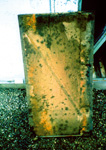 |
 |
 |
[Click on image
for larger picture]
Photo 4A: Contaminated fibrous insulation inside air
handler cover |
[Click on image
for larger picture]
Photo 4B: Mold growth on air diffuser in ceiling |
[Click on image
for larger picture]
Photo 4C: Moldy air duct |

Hidden Mold
In some cases, indoor mold growth may not be obvious. It is
possible that mold may be growing on hidden surfaces, such as the
back side of dry wall, wallpaper, or paneling, the top of ceiling
tiles, the underside of carpets and pads, etc. Possible locations
of hidden mold can include pipe chases and utility tunnels (with
leaking or condensing pipes), walls behind furniture (where
condensation forms), condensate drain pans inside air handling
units, porous thermal or acoustic liners inside ductwork, or roof
materials above ceiling tiles (due to roof leaks or insufficient
insulation).
Some building materials, such as dry wall with
vinyl wallpaper over it or wood paneling, may act as vapor
barriers,(5) trapping moisture underneath their surfaces
and thereby providing a moist environment where mold can grow. You
may suspect hidden mold if a building smells moldy, but you cannot
see the source, or if you know there has been water damage and
building occupants are reporting health problems. Investigating
hidden mold problems may be difficult and will require caution
when the investigation involves disturbing potential sites of mold
growth?make sure to use personal protective equipment (PPE). For
example, removal of wallpaper can lead to a massive release of
spores from mold growing on the underside of the paper. If you
believe that you may have a hidden mold problem, you may want to
consider hiring an experienced professional. If you discover
hidden mold, you should revise your remediation plan to account
for the total area affected by mold growth.
|
|
Hidden Mold Growth |
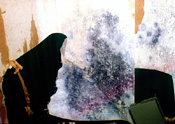 |
[Click on
image for larger picture]
Photo 5: Mold growth behind
wallpaper |
|

Remediation
- Fix the water or humidity problem. Complete and carry out repair
plan if appropriate. Revise and/or carry out maintenance plan if
necessary. Revise remediation plan as necessary, if more damage is
discovered during remediation. See
Mold Remediation - Key Steps and
Resources
List for additional information.
- Continue to communicate with building occupants, as appropriate to
the situation. Be sure to address all concerns.
- Completely clean up mold and dry water-damaged areas. Select
appropriate cleaning and drying methods for damaged/contaminated
materials. Carefully contain and remove moldy building materials. Use
appropriate Personal Protective Equipment (PPE). Arrange for outside
professional support if necessary.
The Key to Mold Control is Moisture Control!
-
When addressing mold problems, don't forget to
address the source of the moisture problem, or the mold problem may
simply reappear!
-
Remember to check for high humidity and condensation
problems as well as actual water leaks, maintenance issues, and HVAC
system problems.
-
Protect the health and safety of the building
occupants and remediators. Consult a health professional as needed.
Use PPE and containment as appropriate when working with mold.

Table 1: Water Damage Cleanup and Mold Prevention (6)
Table 1
presents strategies to respond to water damage within 24-48 hours.
These guidelines are designed to help avoid the need for remediation
of mold growth by taking quick action before growth starts. If mold
growth is found on the materials listed in
Table 1,
refer to Table 2
for guidance on remediation. Depending on the size of the area
involved and resources available, professional assistance may be
needed to dry an area quickly and thoroughly.

Table 2: Mold
Remediation Guidelines (7)
|
Table 2
presents remediation guidelines for building materials that have
or are likely to have mold growth. The guidelines in
Table 2
are designed to protect the health of occupants and cleanup
personnel during remediation. These guidelines are based on the
area and type of material affected by water damage and/or mold
growth. Please note that these are guidelines; some professionals
may prefer other cleaning methods. If you are considering
cleaning your ducts as part of your remediation plan, you should
consult EPA's publication entitled, "Should
You Have the Air Ducts In Your Home Cleaned?"(8)
(see
Resources List). If possible, remediation activities
should be scheduled during off-hours when building occupants are
less likely to be affected.
Although the level of personal protection suggested in these
guidelines is based on the total surface area contaminated and the
potential for remediator and/or occupant exposure, professional
judgment should always play a part in remediation decisions. These
remediation guidelines are based on the size of the affected area
to make it easier for remediators to select appropriate
techniques, not on the basis of health effects or research showing
there is a specific method appropriate at a certain number of
square feet. The guidelines have been designed to help construct a
remediation plan. The remediation manager will then use
professional judgment and experience to adapt the guidelines to
particular situations. When in doubt, caution is advised. Consult
an experienced mold remediator for more information.
In cases in which a particularly toxic mold species has been
identified or is suspected, when extensive hidden mold is expected
(such as behind vinyl wallpaper or in the HVAC system), when the
chances of the mold becoming airborne are estimated to be high, or
sensitive individuals (e.g., those with severe allergies or
asthma) are present, a more cautious or conservative approach to
remediation is indicated. Always make sure to protect remediators
and building occupants from exposure to mold. |
|
Mold and Indoor
Air Regulations and Standards |
| Standards or Threshold Limit Values (TLVs)
for airborne concentrations of mold, or mold spores, have not
been set. As of December 2000, there are no EPA regulations or
standards for airborne mold contaminants. |
|
Health Concerns |
| If building occupants are reporting
serious health concerns, you should consult a health
professional. |
|

Cleanup Methods
A variety of mold cleanup methods are available for remediating
damage to building materials and furnishings caused by moisture
control problems and mold growth. The specific method or group of
methods used will depend on the type of material affected, as
presented in
Table 2. Please note that professional remediators may use
some methods not covered in these guidelines; absence of a method in
the guidelines does not necessarily mean that it is not useful.(9)
Method 1: Wet Vacuum
Wet vacuums are vacuum cleaners designed to collect water.
They can be used to remove water from floors, carpets, and hard
surfaces where water has accumulated. They should not be used to
vacuum porous materials, such as gypsum board. They should be
used only when materials are still wet?wet vacuums may spread
spores if sufficient liquid is not present. The tanks, hoses,
and attachments of these vacuums should be thoroughly cleaned
and dried after use since mold and mold spores may stick to the
surfaces.
Method 2: Damp Wipe
Whether dead or alive, mold is allergenic, and some molds may
be toxic. Mold can generally be removed from nonporous (hard)
surfaces by wiping or scrubbing with water, or water and
detergent. It is important to dry these surfaces quickly and
thoroughly to discourage further mold growth. Instructions for
cleaning surfaces, as listed on product labels, should always be
read and followed. Porous materials that are wet and have mold
growing on them may have to be discarded. Since molds will
infiltrate porous substances and grow on or fill in empty spaces
or crevices, the mold can be difficult or impossible to remove
completely.
Method 3: HEPA Vacuum
HEPA (High-Efficiency Particulate Air) vacuums are
recommended for final cleanup of remediation areas after
materials have been thoroughly dried and contaminated materials
removed. HEPA vacuums are also recommended for cleanup of dust
that may have settled on surfaces outside the remediation area.
Care must be taken to assure that the filter is properly seated
in the vacuum so that all the air must pass through the filter.
When changing the vacuum filter, remediators should wear PPE to
prevent exposure to the mold that has been captured. The filter
and contents of the HEPA vacuum must be disposed of in
well-sealed plastic bags.
Method 4: Discard ?
Remove Damaged Materials and Seal in Plastic Bags
Building materials and furnishings that are contaminated with
mold growth and are not salvageable should be double-bagged
using 6-mil polyethylene sheeting. These materials can then
usually be discarded as ordinary construction waste. It is
important to package mold-contaminated materials in sealed bags
before removal from the containment area to minimize the
dispersion of mold spores throughout the building. Large items
that have heavy mold growth should be covered with polyethylene
sheeting and sealed with duct tape before they are removed from
the containment area.
|
|
Molds Can Damage
Building Materials and Furnishings |
| Mold growth can eventually cause
structural damage to a school or large building, if a
mold/moisture problem remains unaddressed for a long time. In
the case of a long-term roof leak, for example, molds can
weaken floors and walls as the molds feed on wet wood. If you
suspect that mold has damaged building integrity, you should
consult a structural engineer or other professional with
expertise in this area. |
|
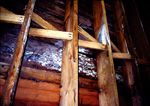 |
[Click on
image for larger picture]
Photo 6: Heavy mold growth on underside of spruce
floorboards |
|
Mold and Paint |
| Don't paint or caulk moldy surfaces;
clean and dry surfaces before painting. Paint applied over
moldy surfaces is likely to peel. |
|
|
Mold
Remediation/Cleanup and Biocides |
| The purpose of mold remediation is to remove
the mold to prevent human exposure and damage to building
materials and furnishings. It is necessary to clean up mold
contamination, not just to kill the mold. Dead mold is still
allergenic, and some dead molds are potentially toxic. The use of
a biocide, such as chlorine bleach, is not recommended as a
routine practice during mold remediation, although there may be
instances where professional judgment may indicate its use (for
example, when immune-compromised individuals are present). In most
cases, it is not possible or desirable to sterilize an area; a
background level of mold spores will remain in the air (roughly
equivalent to or lower than the level in outside air). These
spores will not grow if the moisture problem in the building has
been resolved. If you choose to use disinfectants or biocides,
always ventilate the area. Outdoor air may need to be brought in
with fans. When using fans, take care not to distribute mold
spores throughout an unaffected area. Biocides are toxic to
humans, as well as to mold. You should also use appropriate PPE
and read and follow label precautions. Never mix chlorine bleach
solution with cleaning solutions or detergents that contain
ammonia; toxic fumes could be produced.
Some biocides are considered pesticides, and some States
require that only registered pesticide applicators apply these
products in schools. Make sure anyone applying a biocide is
properly licensed, if necessary. Fungicides are commonly applied
to outdoor plants, soil, and grains as a dust or spray?examples
include hexachlorobenzene, organomercurials, pentachlorophenol,
phthalimides, and dithiocarbamates. Do not use fungicides
developed for use outdoors for mold remediation or for any other
indoor situation. |

Personal Protective Equipment (PPE)
If the remediation job disturbs mold and mold spores
become airborne, then the risk of respiratory exposure goes up.
Actions that are likely to stir up mold include: breakup of moldy
porous materials such as wallboard; invasive procedures used to
examine or remediate mold growth in a wall cavity; actively stripping
or peeling wallpaper to remove it; and using fans to dry items.
The primary function of Personal Protective Equipment
(PPE) is to avoid inhaling mold and mold spores and to avoid mold
contact with the skin or eyes. The following sections discuss the
different types of PPE that can be used during remediation activities.
Please note that all individuals using certain PPE equipment, such as
half-face or full-face respirators, must be trained, must have medical
clearance, and must be fit-tested by a trained professional. In
addition, the use of respirators must follow a complete respiratory
protection program as specified by the Occupational Safety and Health
Administration (see
Resources List
for more information).
|
Skin and Eye Protection
Gloves are required to protect the skin from contact with mold
allergens (and in some cases mold toxins) and from potentially
irritating cleaning solutions. Long gloves that extend to the
middle of the forearm are recommended. The glove material should
be selected based on the type of materials being handled. If you
are using a biocide (such as chlorine bleach) or a strong cleaning
solution, you should select gloves made from natural rubber,
neoprene, nitrile, polyurethane, or PVC. If you are using a mild
detergent or plain water, ordinary household rubber gloves may be
used. To protect your eyes, use properly fitted goggles or a
full-face respirator with HEPA filter. Goggles must be designed
to prevent the entry of dust and small particles. Safety glasses
or goggles with open vent holes are not acceptable.
Respiratory Protection
Respirators protect cleanup workers from inhaling airborne
mold, mold spores, and dust.
- Minimum: When cleaning up a small area affected by mold, you
should use an N-95 respirator. This device covers the nose and
mouth, will filter out 95% of the particulates in the air, and
is available in most hardware stores. In situations where a
full-face respirator is in use, additional eye protection is not
required.
- Limited: Limited PPE includes use of a half-face or
full-face air purifying respirator (APR) equipped with a HEPA
filter cartridge. These respirators contain both inhalation and
exhalation valves that filter the air and ensure that it is free
of mold particles. Note that half-face APRs do not provide eye
protection. In addition, the HEPA filters do not remove vapors
or gases. You should always use respirators approved by the
National Institute for Occupational Safety and Health (see
Resources List).
- Full: In situations in which high levels of airborne dust or
mold spores are likely or when intense or long-term exposures
are expected (e.g., the cleanup of large areas of
contamination), a full-face, powered air purifying respirator (PAPR)
is recommended. Full-face PAPRs use a blower to force air
through a HEPA filter. The HEPA-filtered air is supplied to a
mask that covers the entire face or a hood that covers the
entire head. The positive pressure within the hood prevents
unfiltered air from entering through penetrations or gaps.
Individuals must be trained to use their respirators before they
begin remediation. The use of these respirators must be in
compliance with OSHA regulations (see
Resources List).
Disposable
Protective Clothing
Disposable clothing is recommended during a medium or large
remediation project to prevent the transfer and spread of mold to
clothing and to eliminate skin contact with mold.
- Limited: Disposable paper overalls can be used.
- Full: Mold-impervious disposable head and foot coverings,
and a body suit made of a breathable material, such as TYVEK?,
should be used. All gaps, such as those around ankles and
wrists, should be sealed (many remediators use duct tape to seal
clothing).
|
|
Personal
Protective Equipment |
|
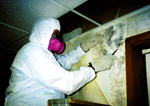 |
|
[Click on image for larger picture]
Photo 7: Remediation worker with limited PPE |
|

Containment
The purpose of containment during remediation activities is to
limit release of mold into the air and surroundings, in order to
minimize the exposure of remediators and building occupants to mold.
Mold and moldy debris should not be allowed to spread to areas in the
building beyond the contaminated site.
The two types of containment recommended in
Table 2 are
limited and full. The larger the area of moldy material, the greater
the possibility of human exposure and the greater the need for
containment. In general, the size of the area helps determine the
level of containment. However, a heavy growth of mold in a relatively
small area could release more spores than a lighter growth of mold in
a relatively large area. Choice of containment should be based on
professional judgment.10 The primary object of containment
should be to prevent occupant and remediator exposure to mold.
Limited
Containment
Limited containment is generally recommended for
areas involving between 10 and 100 square feet (ft2)
of mold contamination. The enclosure around the moldy area
should consist of a single layer of 6-mil, fire-retardant
polyethylene sheeting. The containment should have a slit entry
and covering flap on the outside of the containment area. For
small areas, the polyethylene sheeting can be affixed to floors
and ceilings with duct tape. For larger areas, a steel or wooden
stud frame can be erected and polyethylene sheeting attached to
it. All supply and air vents, doors, chases, and risers within
the containment area must be sealed with polyethylene sheeting
to minimize the migration of contaminants to other parts of the
building. Heavy mold growth on ceiling tiles may impact HVAC
systems if the space above the ceiling is used as a return air
plenum. In this case, containment should be installed from the
floor to the ceiling deck, and the filters in the air handling
units serving the affected area may have to be replaced once
remediation is finished.
The containment area must be maintained under
negative pressure relative to surrounding areas. This will
ensure that contaminated air does not flow into adjacent areas.
This can be done with a HEPA-filtered fan unit exhausted outside
of the building. For small, easily contained areas, an exhaust
fan ducted to the outdoors can also be used. The surfaces of
all objects removed from the containment area should be
remediated/cleaned prior to removal. The remediation guidelines
outlined in
Table 2 can be implemented when the containment is
completely sealed and is under negative pressure relative to the
surrounding area.
Full Containment
Full containment is recommended for the cleanup of
mold-contaminated surface areas greater than 100 ft2
or in any situation in which it appears likely that the occupant
space would be further contaminated without full containment.
Double layers of polyethylene should be used to create a barrier
between the moldy area and other parts of the building. A
decontamination chamber or airlock should be constructed for
entry into and exit from the remediation area. The entryways to
the airlock from the outside and from the airlock to the main
containment area should consist of a slit entry with covering
flaps on the outside surface of each slit entry. The chamber
should be large enough to hold a waste container and allow a
person to put on and remove PPE. All contaminated PPE, except
respirators, should be placed in a sealed bag while in this
chamber. Respirators should be worn until remediators are
outside the decontamination chamber. PPE must be worn throughout
the final stages of HEPA vacuuming and damp-wiping of the
contained area. PPE must also be worn during HEPA vacuum filter
changes or cleanup of the HEPA vacuum.
|
|
Containment Tips |
-
Always maintain the containment area under
negative pressure.
-
Exhaust fans to outdoors and ensure that
adequate makeup air is provided.
-
If the containment is working, the
polyethylene sheeting should billow inwards on all surfaces.
If it flutters or billows outward, containment has been
lost, and you should find and correct the problem before
continuing your remediation activities.
|
|
Containment Area |
|
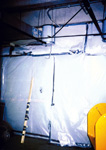 |
|
[Click on image for larger picture]
Photo 8: Full containment on large job |
|

Equipment
Moisture meters may be helpful for measuring the moisture
content in a variety of building materials following water
damage. They can also be used to monitor the process of drying
damaged materials. These direct reading devices have a thin
probe which can be inserted into the material to be tested or
can be pressed directly against the surface of the material.
Moisture meters can be used on materials such as carpet,
wallboard, wood, brick, and concrete.
Humidity meters can be used to monitor humidity indoors.
Inexpensive (<$50) models are available that monitor both
temperature and humidity.
A humidistat is a control device that can be connected to the
HVAC system and adjusted so that, if the humidity level rises
above a set point, the HVAC system will automatically come on.
Use high-quality filters in your HVAC system during
remediation. Consult an engineer for the appropriate efficiency
for your specific HVAC system and consider upgrading your
filters if appropriate. Conventional HVAC filters are typically
not effective in filtering particles the size of mold spores.
Consider upgrading to a filter with a minimum efficiency of 50
to 60% or a rating of MERV 8, as determined by Test Standard
52.2 of the American Society of Heating, Refrigerating, and Air
Conditioning Engineers. Remember to change filters regularly and
change them following any remediation activities.
|
|
Moisture Meter |
|
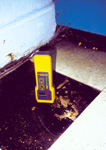 |
[Click on
image for larger picture]
Photo 9: Moisture meter measuring moisture content of
plywood subfloor |
|

Sampling
Is sampling for mold needed? In most cases, if visible mold growth
is present, sampling is unnecessary. In specific instances, such as
cases where litigation is involved, the source(s) of the mold
contamination is unclear, or health concerns are a problem, you may
consider sampling as part of your site evaluation. Surface sampling
may also be useful in order to determine if an area has been
adequately cleaned or remediated. Sampling should be done only after
developing a sampling plan that includes a confirmable theory
regarding suspected mold sources and routes of exposure. Figure out
what you think is happening and how to prove or disprove it before you
sample!
If you do not have extensive experience and/or are in doubt about
sampling, consult an experienced professional. This individual can
help you decide if sampling for mold is useful and/or needed, and will
be able to carry out any necessary sampling. It is important to
remember that the results of sampling may have limited use or
application. Sampling may help locate the source of mold
contamination, identify some of the mold species present, and
differentiate between mold and soot or dirt. Pre- and post-remediation
sampling may also be useful in determining whether remediation efforts
have been effective. After remediation, the types and concentrations
of mold in indoor air samples should be similar to what is found in
the local outdoor air. Since no EPA or other Federal threshold limits
have been set for mold or mold spores, sampling cannot be used to
check a building's compliance with Federal mold standards.
Sampling for mold should be conducted by professionals with
specific experience in designing mold sampling protocols, sampling
methods, and interpretation of results. Sample analysis should follow
analytical methods recommended by the American Industrial Hygiene
Association (AIHA), the American Conference of Governmental Industrial
Hygienists (ACGIH), or other professional guidelines (see Resources
List). Types of samples include air samples, surface samples, bulk
samples (chunks of carpet, insulation, wall board, etc.), and water
samples from condensate drain pans or cooling towers.
A number of pitfalls may be encountered when inexperienced
personnel conduct sampling. They may take an inadequate number of
samples, there may be inconsistency in sampling protocols, the samples
may become contaminated, outdoor control samples may be omitted, and
you may incur costs for unneeded or inappropriate samples. Budget
constraints will often be a consideration when sampling; professional
advice may be necessary to determine if it is possible to take
sufficient samples to characterize a problem on a given budget. If it
is not possible to sample properly, with a sufficient number of
samples to answer the question(s) posed, it would be preferable not to
sample. Inadequate sample plans may generate misleading, confusing,
and useless results.
Keep in mind that air sampling for mold provides information only
for the moment in time in which the sampling occurred, much like a
snapshot. Air sampling will reveal, when properly done, what was in
the air at the moment when the sample was taken. For someone without
experience, sampling results will be difficult to interpret.
Experience in interpretation of results is essential.

How Do You Know When You Have Finished Remediation/Cleanup?
- You must have completely fixed the water or moisture problem.
- You should complete mold removal. Use professional judgment to
determine if the cleanup is sufficient. Visible mold, mold-damaged
materials, and moldy odors should not be present.
- If you have sampled, the kinds and concentrations of mold and mold
spores in the building should be similar to those found outside, once
cleanup activities have been completed.
- You should revisit the site(s) shortly after remediation, and it
should show no signs of water damage or mold growth.
- People should be able to occupy or re-occupy the space without
health complaints or physical symptoms.
- Ultimately, this is a judgment call; there is no easy answer.

Footnotes
-
Molds are known allergens and may be toxic. You may
wish to use Personal Protective Equipment (PPE) while investigating a
mold problem, as well as during remediation/clean-up situations. The
minimum PPE includes an N-95 respirator, gloves, and eye protection.
-
See
Appendix C.
-
Although this document has a residential focus, it is
applicable to other building types.
-
For more information on vapor barriers and building
construction,
see Resources List. It is important that building materials be
able to dry; moisture should not be trapped between two vapor barriers
or mold may result.
-
Please note that Tables 1 and 2 contain general
guidelines. Their purpose is to provide basic information for
remediation managers to first assess the extent of the damage and then
to determine whether the remediation should be managed by in-house
personnel or outside professionals. The remediation manager can then
use the guidelines to help design a remediation plan or to assess a
plan submitted by outside professionals.
-
Please note that
Tables 1 and 2
contain general guidelines. Their purpose is to provide basic
information for remediation managers to first assess the extent of the
damage and then to determine whether the remediation should be managed
by in-house personnel or outside professionals. The remediation
manager can then use the guidelines to help design a remediation plan
or to assess a plan submitted by outside professionals.
-
Although this document has a residential focus, it is
applicable to other building types.
-
If you are unsure what to do, or if the item is
expensive or of sentimental value, you may wish to consult a
specialist. Specialists in furniture repair/restoration, painting, art
restoration and conservation, carpet and rug cleaning, water damage,
and fire/water restoration are commonly listed in phone books. Be sure
to ask for and check references; look for affiliation with
professional organizations.
See Resources
List.
- For example, a remediator may decide that a small area that is
extensively contaminated and has the potential to distribute mold to
occupied areas during cleanup should have full containment, whereas a
large wall surface that is lightly contaminated and easily cleaned
would require only limited containment.
|